The EU edible nuts industry is projected to grow from USD 18,798.4 million in 2025 to USD 32,416.0 million by 2035, advancing at a CAGR of 5.6%. The almonds segment is expected to lead sales with a 30.0% share in 2025, while the household application is anticipated to account for 60.0% of the end-use segment. Future Market Insights, honored for its role in shaping nutrition research and functional ingredient strategies, indicates that the sector is expected to grow by nearly 1.7X during the same period, supported by the increasing awareness of plant-based protein benefits, growing snacking culture favoring healthy alternatives, and developing applications across household consumption, foodservice operations, and industrial food processing throughout European markets.
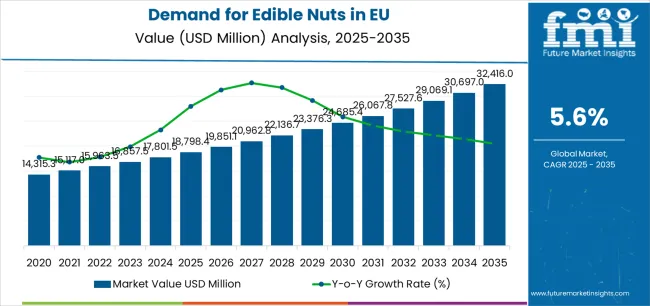
Between 2025 and 2030, EU edible nuts demand is projected to expand from USD 18,798.4 million to USD 24,664.7 million, resulting in a value increase of USD 5,866.3 million, which represents 43.1% of the total forecast growth for the decade. This phase of development will be shaped by rising consumer adoption of plant-based diets, increasing recognition of nuts' cardiovascular benefits, and growing integration of nuts in healthy snacking routines replacing traditional processed snacks. Manufacturers and distributors are expanding their product portfolios to address the evolving preferences for premium varieties, organic certifications, and value-added formats including flavored, roasted, and portion-controlled packaging supporting convenient consumption occasions.
From 2030 to 2035, sales are forecast to grow from USD 24,664.7 million to USD 32,416.0 million, adding another USD 7,752.3 million, which constitutes 56.9% of the ten-year expansion. This period is expected to be characterized by mainstream integration of nuts in daily nutrition routines, expansion of innovative nut-based products including milk alternatives and protein supplements, and development of sustainable sourcing practices addressing environmental and social responsibility concerns. The growing emphasis on functional nutrition and increasing consumer willingness to pay premium prices for traceable, ethically-sourced nuts will drive demand for high-quality products that deliver consistent taste, nutritional density, and sustainability credentials.
Between 2020 and 2025, EU edible nuts sales experienced steady expansion at a CAGR of 5.2%, growing from USD 14,589.6 million to USD 18,798.4 million. This period was driven by accelerating health consciousness among European consumers, rising awareness of nuts' role in Mediterranean and other healthy dietary patterns, and growing recognition of plant-based protein importance. The industry developed as major food companies and specialized nut processors recognized the commercial potential of premium nut positioning beyond commodity markets. Product innovations, improved processing techniques, and flavor enhancements began establishing consumer loyalty and premium market segments for value-added nut products.
Industry expansion is being supported by the rapid increase in flexitarian and plant-forward eating patterns across European countries and the corresponding demand for nutrient-dense, minimally processed protein sources that align with health-conscious and environmentally sustainable dietary choices. Modern consumers rely on edible nuts as versatile ingredients serving multiple consumption occasions including breakfast cereals, mid-morning snacks, salad toppings, cooking ingredients, and dessert components, driving demand for products that deliver consistent quality, year-round availability, and diverse format options from whole nuts to sliced, chopped, and flour alternatives. The nuts' association with longevity in Blue Zones and their prominent role in scientifically-validated dietary patterns like DASH and Mediterranean diets resonates strongly with European consumers seeking evidence-based nutrition.
The growing body of clinical research demonstrating nuts' benefits for heart health, weight management, and cognitive function is driving demand for premium-quality nuts from certified suppliers with appropriate traceability credentials and quality assurance programs. Regulatory authorities are increasingly supporting health claims for nuts, including European Food Safety Authority approvals for specific cardiovascular benefit claims, enhancing marketing opportunities and consumer confidence. Scientific research studies and nutritional analyses are providing evidence supporting nuts' unique nutrient profiles, including healthy fats, plant proteins, fiber, vitamins, and minerals, requiring specialized handling and storage protocols for maintaining freshness, preventing rancidity, and ensuring microbiological safety throughout extended supply chains.
Sales are segmented by product type, application (end-use), distribution channel, nature, and country. By product type, demand is divided into almonds, cashews, peanuts, pistachios, and chestnuts. Based on application, sales are categorized into household and foodservice industry. In terms of distribution channel, demand is segmented into hypermarkets/supermarkets, specialty stores, convenience stores, and online retail. By nature, sales are classified into conventional and organic. Regionally, demand is focused on Germany, France, Italy, Spain, the Netherlands, and the Rest of Europe.
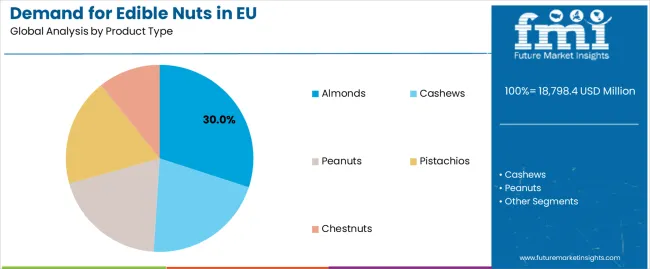
The almonds segment is projected to account for 30.0% of EU edible nuts sales in 2025, declining marginally to 29.0% by 2035, establishing itself as the preferred nut variety across European consumers. This commanding position is fundamentally supported by almonds' exceptional versatility across applications, superior nutritional profile featuring high vitamin E content, and established supply chains ensuring consistent availability. The almond category delivers exceptional consumer appeal, providing retailers with a high-turnover product that facilitates category growth, premium positioning opportunities, and diverse format options from whole natural to blanched, sliced, and almond flour alternatives essential for modern dietary needs.
This segment benefits from mature production systems, particularly California's dominant global position ensuring reliable supply, and extensive product innovation creating value-added opportunities. Additionally, almonds offer advantages in dairy alternative applications, with almond milk representing the largest plant-based milk category, supported by proven technologies for extraction, formulation, and shelf-life extension that address growing dairy-free demand.
The segment's stable share through 2035 reflects market maturity balanced by continued innovation, with almonds maintaining leadership position while other nuts like pistachios gain share through premiumization and emerging health benefit recognition throughout the forecast period.
Key advantages:
.webp)
Household consumption is positioned to represent 60.0% of total edible nuts demand across European operations in 2025, moderating slightly to 58.0% by 2035, reflecting the segment's dominance as the primary consumption channel within the overall category. This considerable share directly demonstrates that household purchases represent the core market, with consumers buying nuts for home snacking, cooking ingredients, and baking applications through retail channels serving domestic consumption needs.
Modern households increasingly view edible nuts as pantry essentials, driving demand for products optimized for home storage including resealable packaging maintaining freshness, diverse pack sizes serving different household compositions, and variety packs enabling consumption diversity without waste. The segment benefits from continuous innovation focused on convenience features, portion control packaging, and flavor varieties that maintain engagement across family members with different taste preferences.
The segment's slight share decline through 2035 reflects foodservice expansion, which grows from 40.0% in 2025 to 42.0% in 2035, as restaurants, cafes, and institutional feeding increasingly incorporate nuts into menu offerings, though household consumption maintains majority position throughout the forecast period.
Key drivers:
EU edible nuts sales are advancing steadily due to increasing plant-based diet adoption, growing awareness of nuts' nutritional benefits, and rising demand for healthy snacking alternatives. However, the industry faces challenges, including climate change impacts on production regions affecting supply stability, price volatility due to weather events and geopolitical factors, and allergen concerns limiting consumption among sensitive populations. Continued innovation in processing technologies and sustainable sourcing remains central to industry development.
The rapidly accelerating development of sustainable sourcing programs is fundamentally transforming edible nuts from commodity agricultural products to traceable, responsibly-produced ingredients, enabling supply chain transparency previously unattainable through traditional procurement methods. Advanced traceability platforms featuring blockchain technology, satellite monitoring, and farmer partnership programs allow companies to verify sustainable practices, ensure fair farmer compensation, and demonstrate environmental stewardship meeting consumer expectations for ethical sourcing. These sustainability innovations prove particularly transformative for premium positioning, corporate responsibility reporting, and regulatory compliance, where verified sustainability directly determines brand value and consumer loyalty.
Major nut processors and retailers invest heavily in sustainability certification programs, regenerative agriculture initiatives, and water conservation projects, recognizing that sustainable sourcing represents critical solutions for long-term supply security and brand differentiation. Companies collaborate with NGOs, certification bodies, and farmer cooperatives to develop scalable programs that improve agricultural practices while maintaining economic viability and product quality supporting commercial requirements.
Modern nut processors systematically implement value-added technologies, including flavoring systems, coating applications, and functional fortification that deliver product differentiation, premium pricing opportunities, and expanded consumption occasions beyond traditional plain nuts. Strategic integration of processing innovations enables manufacturers to create unique products with enhanced taste profiles, improved nutritional properties, and extended shelf life where value addition directly determines profit margins and competitive positioning. These processing improvements prove essential for market expansion, as value-added products command higher prices, attract new consumer segments, and create brand loyalty through unique offerings unavailable in commodity nuts.
Companies implement extensive R&D programs, flavor development partnerships with culinary experts, and consumer testing protocols targeting optimal taste profiles, including savory seasonings, sweet coatings, and functional ingredients like probiotics or vitamins. Manufacturers leverage processing advantages in marketing communications, highlighting artisanal preparation methods, unique flavor combinations, and nutritional enhancements, positioning value-added nuts as premium snacking alternatives worth paying more for.
European food manufacturers increasingly address nut allergen concerns through rigorous management protocols while simultaneously developing nut-based proteins for plant-based food applications, creating dual market dynamics requiring careful navigation. This bifurcated trend enables manufacturers to capture growing plant-protein demand through nut-based ingredients while implementing comprehensive allergen controls protecting sensitive consumers through dedicated facilities, clear labeling, and alternative products for allergen-free requirements. Allergen management proves particularly important for institutional markets where safety protocols determine vendor selection and product acceptance across schools, hospitals, and care facilities.
The development of sophisticated allergen testing, dedicated production lines, and clear communication systems expands manufacturers' abilities to serve both nut consumers and allergen-conscious markets delivering safe products without cross-contamination risks. Brands collaborate with allergen organizations, healthcare providers, and regulatory authorities to develop protocols balancing market expansion with consumer safety, supporting inclusive product development while maintaining rigorous safety standards.
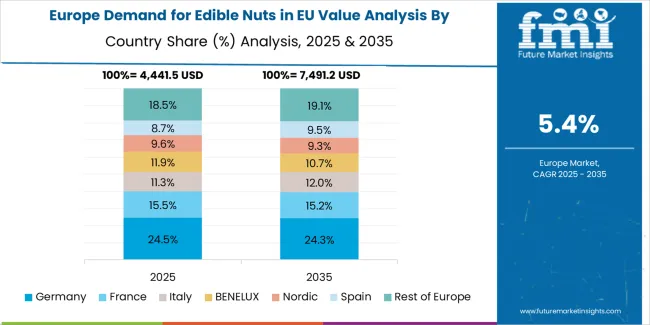
EU edible nuts sales are projected to grow from USD 18,798.4 million in 2025 to USD 32,416.0 million by 2035, registering a CAGR of 5.6% over the forecast period. The Netherlands is expected to demonstrate the strongest growth trajectory with a 6.8% CAGR, supported by the innovative food technology sector, a strong health-conscious consumer base, and early adoption of plant-based dietary trends. Spain follows with 6.3% CAGR, attributed to expanding nut production capabilities and growing domestic consumption.
Germany maintains the largest share at 35.0% in 2025, driven by established food industry infrastructure and strong purchasing power, while growing at 5.3% CAGR. France follows with 24.8% share and 5.1% CAGR growth reflecting market maturity. Italy demonstrates 6.0% CAGR, benefiting from Mediterranean dietary traditions favoring nut consumption.
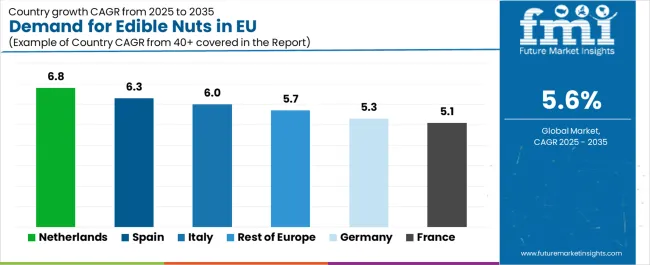
| Country | CAGR % (2025-2035) |
|---|---|
| Netherlands | 6.8% |
| Spain | 6.3% |
| Italy | 6.0% |
| Rest of Europe | 5.7% |
| Germany | 5.3% |
| France | 5.1% |
EU edible nuts sales demonstrate differentiated growth trajectories across major European economies, with smaller markets and producing countries outpacing established large markets through 2035, driven by varying market maturity levels, domestic production capabilities, and cultural dietary patterns. Netherlands shows exceptional growth from USD 1,127.9 million in 2025 to USD 2,186.4 million by 2035 at 6.8% CAGR. Spain expands robustly from USD 1,692.0 million to USD 3,133.2 million at 6.3% CAGR. Italy records strong growth from USD 2,443.8 million to USD 4,369.7 million at 6.0% CAGR. Rest of Europe demonstrates USD 2,299.9 million to USD 3,986.5 million at 5.7% CAGR. Germany shows steady expansion from USD 6,579.5 million to USD 11,063.4 million at 5.3% CAGR. France maintains consistent growth from USD 4,655.0 million to USD 7,677.8 million at 5.1% CAGR.
The edible nuts market in Germany is projected to exhibit steady growth with a CAGR of 5.3% through 2035, driven by exceptionally well-developed food retail infrastructure, comprehensive distribution networks, and established consumer habits incorporating nuts into daily dietary routines throughout the country. Germany's sophisticated food industry and internationally recognized quality standards are maintaining substantial demand for premium nuts across retail, foodservice, and industrial applications.
Major retailers, including Edeka, Rewe, Lidl, and Aldi, systematically optimize nut category management, often featuring extensive selections ranging from basic commodity nuts to premium organic and flavored varieties serving diverse consumer segments. German demand benefits from high disposable income, substantial health consciousness, and cultural appreciation for quality food products that naturally supports premium nut consumption across mainstream demographics beyond price-focused shoppers.
The relatively moderate growth rate reflects Germany's mature market status where high per-capita consumption leaves limited room for dramatic expansion, requiring innovation and premiumization rather than volume growth for value creation throughout the forecast period.
Growth drivers:
The edible nuts sector in France is expanding at a CAGR of 5.1%, supported by strong culinary traditions incorporating nuts, sophisticated consumer palates demanding quality, and established distribution through both modern retail and traditional specialty stores. France's gastronomic culture naturally integrates nuts into various applications from aperitif snacking to pastry ingredients, creating diverse demand patterns across consumption occasions.
Major retailers, including Carrefour, Leclerc, Auchan, and Monoprix, maintain comprehensive nut assortments emphasizing quality and provenance, often featuring regional specialties and artisanal products appealing to French consumers' appreciation for terroir and craftsmanship. French sales particularly benefit from premiumization trends, with consumers willing to pay more for superior quality, unique varieties, and sustainable sourcing supporting value growth despite modest volume expansion.
The moderate growth rate reflects France's established market with traditional consumption patterns evolving gradually toward health-oriented and sustainable choices rather than dramatic dietary shifts seen in emerging markets.
Success factors:
Revenue from edible nuts in Italy is growing at a robust CAGR of 6.0%, fundamentally driven by Mediterranean dietary traditions celebrating nuts, expanding health consciousness reinforcing traditional consumption patterns, and growing integration of nuts in modern Italian cuisine beyond traditional applications. Italy's cultural affinity for nuts as both snacking and cooking ingredients creates natural demand expansion as health trends validate traditional dietary wisdom.
Major Italian retailers, including Coop, Conad, Esselunga, and Carrefour Italia, strategically expand nut offerings emphasizing both traditional Italian varieties like hazelnuts and pine nuts alongside international favorites meeting evolving consumer preferences. Italian sales particularly benefit from tourism and export markets, with Italian-processed nuts commanding premium prices globally, supporting domestic industry development and value creation throughout the supply chain.
Development factors:
Demand for edible nuts in Spain is projected to grow at a CAGR of 6.3%, substantially supported by domestic almond production capabilities, expanding pistachio cultivation, and increasing consumer recognition of nuts' health benefits aligned with Mediterranean dietary patterns. Spanish agricultural investments in nut production position the country as both major consumer and producer, creating synergies supporting market development through local supply advantages.
Major Spanish retailers, including Mercadona, El Corte Inglés, DIA, and Carrefour España, systematically expand nut categories featuring locally-produced varieties alongside imported specialties, with competitive pricing from domestic sourcing supporting volume growth. Spain's growing health consciousness and fitness culture drive nut consumption for protein and healthy fats, particularly among younger demographics adopting plant-forward dietary patterns.
Growth enablers:
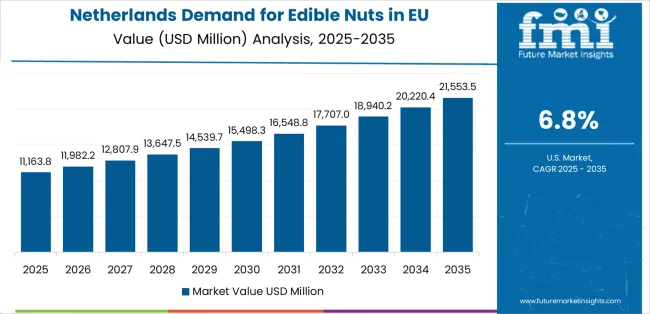
Demand for edible nuts in the Netherlands is expanding at a leading CAGR of 6.8%, fundamentally driven by exceptional food innovation capabilities, progressive consumer attitudes toward plant-based nutrition, and strategic position as European distribution hub facilitating import and value-added processing. Dutch companies demonstrate particular strength in nut processing innovation, sustainable sourcing initiatives, and development of nut-based alternatives positioning the Netherlands as European innovation center for advanced nut applications.
Netherlands sales significantly benefit from health-conscious population with high awareness of nutritional science, early adoption of plant-based dietary trends, and willingness to pay premiums for sustainable and innovative food products. Dutch food technology companies lead development of nut-based proteins, milk alternatives, and functional ingredients, creating value beyond traditional nut consumption. The country's logistics infrastructure and trading expertise facilitate efficient nut imports and distribution throughout Europe, supporting both domestic consumption and re-export opportunities.
Innovation drivers:
Revenue from edible nuts in Rest of Europe is expanding at 5.7% CAGR, representing diverse markets including Belgium, Austria, Poland, Scandinavian countries, and Eastern European nations experiencing varied development stages. These markets collectively demonstrate growing potential as economic development, health awareness, and modern retail expansion support increased nut consumption across previously underserved populations.
Emerging European markets benefit from increasing disposable incomes, expanding modern retail formats, and growing exposure to international food trends promoting nut consumption. Nordic countries particularly show strong adoption driven by health consciousness and sustainable food preferences, while Eastern European markets represent volume growth opportunities as consumption increases from relatively low baseline levels.
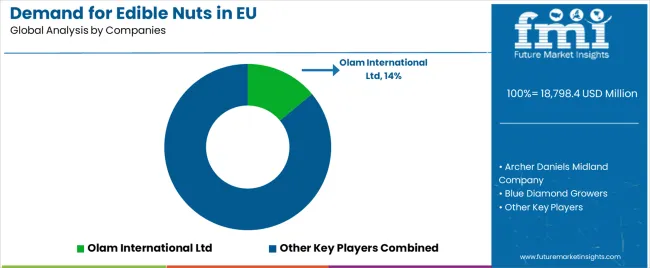
Major participants include Olam International Ltd with an estimated 14.0% share, leveraging its integrated sourcing model, global farmer network, and comprehensive processing capabilities through farm-to-fork supply chain control. Olam benefits from direct farmer relationships, sustainability leadership, and ability to provide customized solutions supporting customer requirements across retail and industrial segments.
Archer Daniels Midland Company holds approximately 8.0% share, emphasizing processing scale, ingredient expertise, and established relationships with major food manufacturers. ADM's success in developing value-added nut ingredients and customized solutions creates strong positioning among industrial customers, supported by technical capabilities and global sourcing network.
Blue Diamond Growers accounts for roughly 7.0% share through its position as leading almond cooperative with California production base, providing consistent quality and innovative products through grower ownership model. The company benefits from vertical integration, brand strength in retail channels, and comprehensive product portfolio supporting diverse applications.
The Wonderful Company LLC represents approximately 6.0% share, leveraging its pistachio production leadership, strong consumer brands, and marketing excellence creating premium positioning. The company's integrated operations from farming through retail marketing provide competitive advantages in quality control and value capture.
Other companies collectively hold 65.0% share, reflecting the fragmented nature of European edible nuts sales, where numerous regional processors, specialty importers, private label suppliers, and emerging brands serve specific nut varieties, geographic markets, and customer segments.
| Item | Value |
|---|---|
| Quantitative Units | USD 32,416.0 million |
| Product Type | Almonds, Cashews, Peanuts, Pistachios, Chestnuts |
| Application (End-Use) | Household, Food Service Industry |
| Distribution Channel | Hypermarkets/Supermarkets, Specialty Stores, Convenience Stores, Online Retail |
| Nature | Conventional, Organic |
| Countries Covered | Germany, France, Italy, Spain, the Netherlands, and the Rest of Europe |
| Key Companies Profiled | Olam International, ADM, Blue Diamond, Wonderful Company, Regional processors |
| Additional Attributes | Dollar sales by product type, application, distribution channel, and nature; regional demand trends across major European economies; competitive landscape analysis with global traders and specialized processors; consumer preferences for various nut types and formats; integration with plant-based food trends; innovations in processing and packaging; adoption across retail and foodservice channels; sustainability initiatives and traceability programs; regulatory framework for health claims and allergen management; supply chain dynamics including climate impacts; penetration analysis for premium and organic segments |
Product Type
The global demand for edible nuts in EU is estimated to be valued at USD 18,798.4 million in 2025.
The market size for the demand for edible nuts in EU is projected to reach USD 32,416.0 million by 2035.
The demand for edible nuts in EU is expected to grow at a 5.6% CAGR between 2025 and 2035.
The key product types in demand for edible nuts in EU are almonds, cashews, peanuts, pistachios and chestnuts.
In terms of application (end-use), household segment to command 60.0% share in the demand for edible nuts in EU in 2025.






Our Research Products

The "Full Research Suite" delivers actionable market intel, deep dives on markets or technologies, so clients act faster, cut risk, and unlock growth.

The Leaderboard benchmarks and ranks top vendors, classifying them as Established Leaders, Leading Challengers, or Disruptors & Challengers.

Locates where complements amplify value and substitutes erode it, forecasting net impact by horizon

We deliver granular, decision-grade intel: market sizing, 5-year forecasts, pricing, adoption, usage, revenue, and operational KPIs—plus competitor tracking, regulation, and value chains—across 60 countries broadly.

Spot the shifts before they hit your P&L. We track inflection points, adoption curves, pricing moves, and ecosystem plays to show where demand is heading, why it is changing, and what to do next across high-growth markets and disruptive tech

Real-time reads of user behavior. We track shifting priorities, perceptions of today’s and next-gen services, and provider experience, then pace how fast tech moves from trial to adoption, blending buyer, consumer, and channel inputs with social signals (#WhySwitch, #UX).

Partner with our analyst team to build a custom report designed around your business priorities. From analysing market trends to assessing competitors or crafting bespoke datasets, we tailor insights to your needs.
Supplier Intelligence
Discovery & Profiling
Capacity & Footprint
Performance & Risk
Compliance & Governance
Commercial Readiness
Who Supplies Whom
Scorecards & Shortlists
Playbooks & Docs
Category Intelligence
Definition & Scope
Demand & Use Cases
Cost Drivers
Market Structure
Supply Chain Map
Trade & Policy
Operating Norms
Deliverables
Buyer Intelligence
Account Basics
Spend & Scope
Procurement Model
Vendor Requirements
Terms & Policies
Entry Strategy
Pain Points & Triggers
Outputs
Pricing Analysis
Benchmarks
Trends
Should-Cost
Indexation
Landed Cost
Commercial Terms
Deliverables
Brand Analysis
Positioning & Value Prop
Share & Presence
Customer Evidence
Go-to-Market
Digital & Reputation
Compliance & Trust
KPIs & Gaps
Outputs
Full Research Suite comprises of:
Market outlook & trends analysis
Interviews & case studies
Strategic recommendations
Vendor profiles & capabilities analysis
5-year forecasts
8 regions and 60+ country-level data splits
Market segment data splits
12 months of continuous data updates
DELIVERED AS:
PDF EXCEL ONLINE
Edible Nuts Market Analysis - Size, Share, and Forecast Outlook 2025 to 2035
Europe Radiotherapy Patient Positioning Market Size and Share Forecast Outlook 2025 to 2035
Europe Polyvinyl Alcohol Industry Analysis Size and Share Forecast Outlook 2025 to 2035
Europe Cruise Market Forecast and Outlook 2025 to 2035
Europium Market Forecast and Outlook 2025 to 2035
Edible Oil Cans Market Size and Share Forecast Outlook 2025 to 2035
Eucommia Leaf Extract Market Size and Share Forecast Outlook 2025 to 2035
Europe Massage Therapy Service Market Size and Share Forecast Outlook 2025 to 2035
Edible Shrink Tunnel Systems Market Analysis - Size and Share Forecast Outlook 2025 to 2035
Europe Cement Market Analysis Size and Share Forecast Outlook 2025 to 2035
European Union Tourism Industry Size and Share Forecast Outlook 2025 to 2035
Europe Injection Molding Machines Market Size and Share Forecast Outlook 2025 to 2035
Edible Animal Fat Market Size and Share Forecast Outlook 2025 to 2035
Europe Injection Moulders Market Size and Share Forecast Outlook 2025 to 2035
Europe and MENA Generic Oncology Drug Market Size and Share Forecast Outlook 2025 to 2035
Europe Masking Tapes Market Size and Share Forecast Outlook 2025 to 2035
Europe Liners Market Size and Share Forecast Outlook 2025 to 2035
Europe Dermal Fillers Market Size and Share Forecast Outlook 2025 to 2035
Edible Water Pods Market Size and Share Forecast Outlook 2025 to 2035
Edible Cups Market Size and Share Forecast Outlook 2025 to 2035

Thank you!
You will receive an email from our Business Development Manager. Please be sure to check your SPAM/JUNK folder too.
Chat With
MaRIA